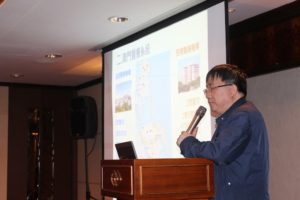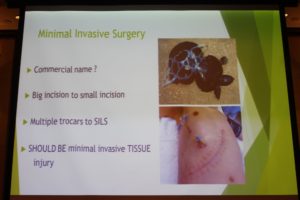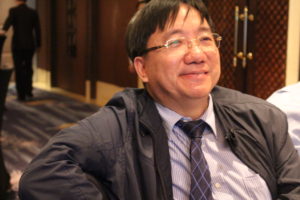
By Peace Post Staff/ Images: Christopher Cottrell
Hong Kong’s young doctors are cutting out new paths in medicine—and expanding their understanding of resources in the Greater Pearl Bay Area, such as Macau medicine and Shenzhen 3D printing.
Indeed, over the weekend the Younger Fellows Chapter of the Hong Kong College of Surgeons held a science symposium dinner in Macau. This was done in conjunction with the Faculty of Health Sciences at the Macau University of Science and Technology (MUST), and Kiang Wu Hospital. Medtronic from Hong Kong was an organizing sponsor.

Dr. Calvin Hoi Kwan Mak, an associate consultant in the Department of Neurosurgery at Queen Elizabeth’s Hospital, explained that, “This is the first event of its kind for our Younger Fellows Chapter for the College of Surgeons for Hong Kong to come to Macau.”

Regarding the parent organization, Dr. Mak says, “This is a very prominent group to get all the surgeons for training and for service improvement. We’ve come here and it’s a great honor to be received by different parties and hospitals in Macau to discuss and share ideas of how surgical training and services work here.”

Dr. Mak continued, “One of the most exciting developments is simulation training. It’s a big discussion all over in Hong Kong because it creates safety to both patients and surgeons. Traditionally, we learned while we did operations. Well that of course can pose potential threats to the patients if the doctors are very junior. But in simulation there’s no such problem.”

Dr. Mak noted, “The most advanced trends with simulation training incorporates 3D printing. For standard simulation, it’s a fixed device that’s used to train hundreds of surgeons or doctors. But as you know for human beings, there are a lot of variations. With 3D printing we can really do various scenarios. In surgery, it gives us different models so we can easily adapt and train for different kinds of patients. Its one of the most exciting technologies, this 3D printing.”

Dr. Mak said, “For now we have a lot of collaborations and conferences and discussion among international 3D printing experts, including those from Shenzhen as well.” Shenzhen, after all, leads China’s 3D printing revolution. He added, “We work with the Hong Kong Hospital Authority and this year at their convention we are promoting more technology and how we can incorporate it into daily practice.”

Another presenter of the evening symposium was the Youth Chapter’s president, Dr. Emily Yat Ling Lai, an associate consultant in the department of surgery at Queen Elizabeth Hospital.

Dr. Lai said, “I specialize in head and neck injury. I am discussing cancer such as thyroid and larynx and so on. I help the Hong Kong College of Surgeons to teach in simulation training such as laparoscopic skills course.”

Dr. Lai added, “Simulation training is the new direction for all surgical training. Nowadays, simulation training is very advanced, it really mimics the real body. It really gives trainees hands on experience well before they can operate on a live human.”

Guest speakers from Macau included Dr. Heong Keong Pang, Chief of General Surgery at the Macau government Conde de S. Januário Hospital, and Dr. Billy Chan, Director for the Center of Medical Excellence at the Faculty of Health Sciences at MUST.

Upon hearing that Dr. Pang discuss Macau and his minimally invasive techniques, Dr. Mak said, “In the public hospitals in Hong Kong we don’t yet use this. We make three insertions instead of the single insertion!”
“But there are private clinics in Hong Kong that do,” adds Dr. Chan.

Dr. Chan, as a pioneer in establishing simulation training centers in China mentioned the advanced center at Peking University Peoples’ Hospital in Beijing—where he had led a medical delegation of doctors from Brazil, Macau, Hong Kong, Philippines, and Portugal, among others, the previous week.

Asked by one Hong Kong young doctor about future trends in simulation training, Dr. Chan said, “Last year I was in Stanford and Maryland discussing with experts about printing skin, tissue, which is very, very hard. Printing on hard layers like bones or teeth are easier than skin to do. In the future, surgeons will love it if they can get skin printed, especially for burns patients.”

Dr. Chan added, “When we see the computer science and technology bounce forward so fast, I am hopeful we’ll see many breakthroughs in this field within the next five years.”

Beyond this trip, the Hong Kong doctors had been hearing about Macau’s medical strides from Prof. Niv Patil, Director of the Hong Kong University of Bau Institute of Medical and Health Sciences Education. Prof. Patil has been presenting with Dr. Chan’s Sino-Luso International Medical Forums and helping the Macau medical simulation movement.

Many of the young doctors there from Hong Kong had studied directly under him.
Dr. Mak added, “He was my professor and is amazing. We all love Professor Patil.”
 Peace Post Asia Healthier News For The World
Peace Post Asia Healthier News For The World



